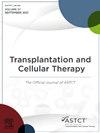输血依赖型β-地中海贫血患者的β-细胞基因添加治疗可产生持久的血红蛋白A (HbA)长达10年的随访
IF 3.6
3区 医学
Q2 HEMATOLOGY
引用次数: 0
摘要
β-细胞基因添加疗法是一种用于输血依赖性β-地中海贫血(TDT)的一次性治疗方法,通过添加β-珠蛋白基因(βT87Q)的功能拷贝来解决疾病的根本原因。在这里,我们报告了接受β细胞治疗的参与者的长期结果。方法:完成为期2年的1/2期(HGB-204 [NCT01745120];HGB-205 [NCT02151526])或第3期(HGB-207 [NCT02906202]);HGB-212 [NCT03207009])的β细胞研究,参与者符合长期13年随访研究LTF-303 (NCT02633943)的条件。通过最后一次随访报告临床疗效、铁稳态、健康相关生活质量和安全性。截至2024年2月,63名参与者(中位年龄:17岁[4-35岁])接受了β -细胞治疗,随后参加了LTF-303(中位随访时间:71.2个月[34.5-121.4个月]);2名受试者随访10个月,51名(81.0%)随访至少5个月,1名受试者在39个月后因个人原因撤回同意。外周血载体拷贝数和HbAT87Q水平在第6个月时保持稳定,在研究期间持续长达10年,并且在β细胞药物生产优化后的3期比1/2期更高,这与商业过程相似。在第1/2期,15/22(68.2%)的参与者实现了输血独立性(TI;TI期间加权平均血红蛋白(Hb)中位数[范围]为10.24 [9.1-13.1]g/dL)。在第3阶段,37/41(90.2%)参与者达到TI(图;加权平均Hb, 11.24 [9.8-13.9] g/dL)。不同基因型(β0/β0 vs非β0/β0)和年龄的转导效率、药效学、TI率和加权平均Hb相似。在获得TI的1/2期和3期参与者中,第60个月血清铁蛋白的中位(范围)变化为-1951.0(-7079至1345)ng/mL (n=39),肝铁浓度(LIC)为-2.9(-20.6至9.6)mg Fe/g干重(dw;n = 31)。根据医生的判断,28/37(75.7%)的3期患者不再接受铁螯合治疗,其中22(78.6%)的患者接受了5 mg Fe/g dw。在第24个月,SF-36健康调查问卷(SF-36)心理成分总结和SF-36身体成分总结以及36个月的儿科生活质量量表总分在第60个月时维持在高于正常人群平均水平的临床有意义的改善。所有完成问卷调查的26名参与者都报告了使用beti-cel的总体益处。输注后2年未发生与β细胞相关的严重不良事件。没有恶性肿瘤,插入性肿瘤,或载体衍生的复制能力慢病毒的报道。结论:对于不同基因型和年龄的TDT患者,通过实现持久的TI和长达10年的良好安全性,beti -cel是一种潜在的治愈疗法。这些数据将为现实世界的治疗决策提供信息。本文章由计算机程序翻译,如有差异,请以英文原文为准。
Betibeglogene Autotemcel (Beti-cel) Gene Addition Therapy Results in Durable Hemoglobin A (HbA) Production with up to 10 Years of Follow-up in Participants with Transfusion-Dependent β-Thalassemia
Introduction
Beti-cel gene addition therapy is a one-time treatment for transfusion-dependent β-thalassemia (TDT) that adds functional copies of the β-globin gene (βT87Q) to address the underlying cause of disease. Here, we report long-term outcomes of participants treated with beti-cel.
Methods
After completion of a 2-year phase 1/2 (HGB-204 [NCT01745120]; HGB-205 [NCT02151526]) or phase 3 (HGB-207 [NCT02906202]; HGB-212 [NCT03207009]) beti-cel study, participants were eligible for the long-term, 13-year follow-up study, LTF-303 (NCT02633943). Clinical efficacy, iron homeostasis, health-related quality of life, and safety are reported through last follow-up.
Results
As of Feb 2024, 63 participants (median [range] age: 17 [4-35] y) received beti-cel and subsequently enrolled in LTF-303 (median [range] follow-up: 71.2 [34.5-121.4] mo); 2 participants had 10 y of follow-up, 51 (81.0%) had at least 5 y, and 1 withdrew consent after 39 mo for personal reasons. Peripheral blood vector copy number and HbAT87Q levels were stable by month 6, sustained across studies up to 10 y, and were higher in phase 3 vs phase 1/2 following beti-cel drug product manufacturing optimization, which is similar to the commercial process. In phase 1/2, 15/22 (68.2%) participants achieved transfusion independence (TI; median [range] weighted average hemoglobin (Hb) during TI, 10.24 [9.1-13.1] g/dL). In phase 3, 37/41 (90.2%) participants achieved TI (Figure; weighted average Hb, 11.24 [9.8-13.9] g/dL). Transduction efficiency, pharmacodynamics, TI rate, and weighted average Hb were similar across genotypes (β0/β0 vs non-β0/β0) and ages. Among phase 1/2 and phase 3 participants who achieved TI, median (range) change from baseline in serum ferritin at month 60 was -1951.0 (-7079 to 1345) ng/mL (n=39), and liver iron concentration (LIC) was -2.9 (-20.6 to 9.6) mg Fe/g dry weight (dw; n=31). At physician discretion, 28/37 (75.7%) phase 3 participants were no longer receiving iron chelation therapy, and 22 of those 28 (78.6%) had LIC <5 mg Fe/g dw. Clinically meaningful improvements in the Short Form-36 Health Survey Questionnaire (SF-36) mental component summary at month 24 and SF-36 physical component summary and Pediatric Quality of Life Inventory total score at month 36 were sustained above the normative population mean at month 60. All 26 participants who completed a questionnaire reported an overall benefit with beti-cel. No beti-cel–related serious adverse events occurred >2 y after infusion. No malignancies, insertional oncogenesis, or vector-derived replication-competent lentivirus were reported.
Conclusion
Beti-cel is a potentially curative therapy for patients with TDT across genotypes and ages through achievement of durable TI and a favorable safety profile up to 10 y. These data will inform real-world treatment decisions.
求助全文
通过发布文献求助,成功后即可免费获取论文全文。
去求助
来源期刊

Transplantation and Cellular Therapy
Medicine-Hematology
CiteScore
7.00
自引率
15.60%
发文量
1061
审稿时长
51 days
 求助内容:
求助内容: 应助结果提醒方式:
应助结果提醒方式:


